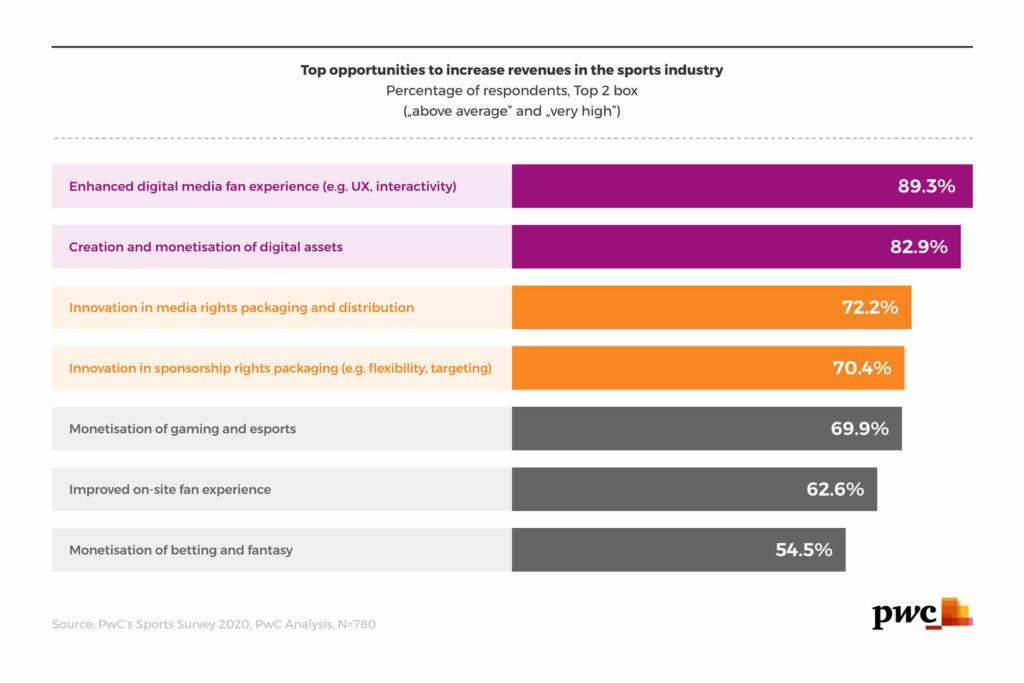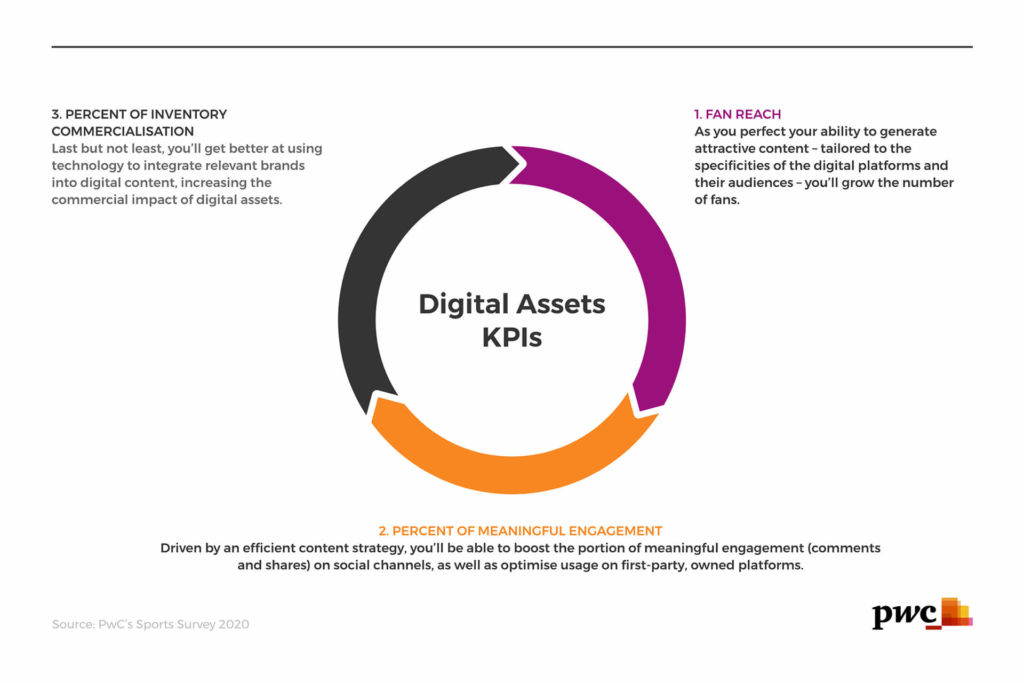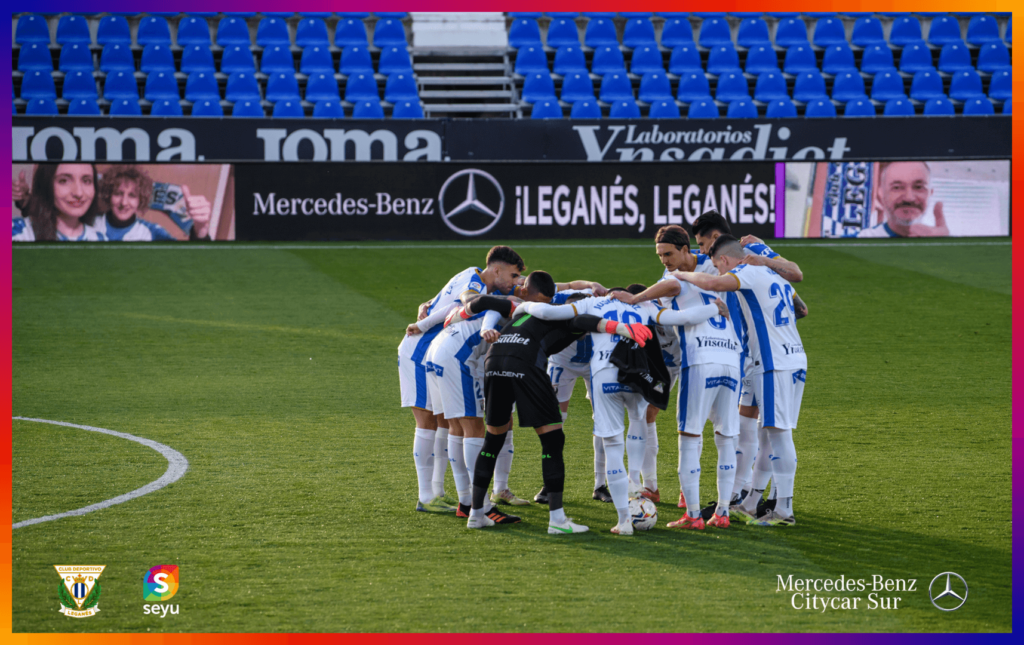Industry leaders: monetizing digital assets is the way to get the sports business back on track
“Never waste a good crisis” – Check out how digital assets can unlock a broad space for growth!
Facing today’s dramatic challenges and tomorrow’s uncertainties, the sports industry urgently needs to ask itself what concrete initiatives should be prioritized to accelerate growth despite significantly reduced resources. In the comprehensive research made by the PWC, more than 780 industry experts tried to find how to tackle the issues and finally get the business back on track. One of the TOP takeaways is that digital assets are not just creative tools for fan engagement anymore but a crucial area to increase growth, generate a new revenue stream and build a long lasting sustainable ecosystem.
“Never waste a good crisis” – the quote from Sir Winston Churchill briefly summarizes the current situation in almost all industries. Strong companies are investing, the less fortunate players are trying to survive. Although the involvement of each economic player is variant, one thing is sure: the crisis has to be successfully managed.
The pandemic crisis has revealed systemic weaknesses within the sports sector, which makes a scenario of imminent recovery highly unlikely. But as Churchill said, we should see the crisis as an opportunity to grow. It is time to introduce the long-delayed developments!
Digital assets can unlock a broad space for growth
The yearly research of PwC was conducted in this hectic environment between June and August through an online questionnaire distributed to sports industry leaders around the world. They have received 780 responses across more than 50 countries, which gives the credibility and transparency of this comprehensive report. Without being too detail-oriented, in this article we have introduced primarily the discoveries that kept the OPPORTUNITY in focus.
On the bright side, most sports leaders agree that sports’ capacity to engage audiences remains crucial, as interest in live sports content is not expected to drop. But the way fans want to consume it changes even more rapidly than before.
The pandemic has significantly weakened physical entertainment, reinforcing the value of both immersive and interactive technologies to compensate for sports’ diminished visual and social experiences. Highly rated by survey respondents, digital assets can unlock a broad space for growth in particular by making use of the rising interest in short-form and on-demand content.
The results of the survey also show that sports leaders fully recognize the digital fan experience as a TOP priority, although few organizations have yet managed to deliver it in a way that allows it to acquire and retain fans sustainably.

Digital fan experience and assets are top priorities in sports business
Digital assets are touted as a significant opportunity by sports leaders, ranked second as a top prospect to increase revenues. In the context of transition from linear to digital consumption and growing interest in non-live content, digital assets can indeed provide an opportunity to de-risk dependency on live events and diversify revenue streams.
As the report summarizes, to harness this potential, it is essential that rights owners advance their ability to clearly package, value and commercialize digital assets, moving away from merely considering them as a tool for indirect sponsorship monetization.
Producing creative content is great, monetizing them is vital
As PwC highlighted, making digital assets an integral part of the commercial strategy requires alignment and concerted progress across multiple dimensions within the organization, including strategy, structure, leadership, performance and technology.
The report singled out three main key performance indicators to track progress towards greater maturity in commercializing digital inventory. Each element works incrementally and ensures a compounding effect to uplift revenues.
1. Fan reach
As organizations perfect the ability to generate attractive content, they will grow the number of fans.
2. Percent of meaningful engagement
Driven by an efficient content strategy, organizations will be able to boost the portion of meaningful engagement (eg. comments and shares) on social channels, as well as optimize usage on first-party, owned platforms.
3. Percent of inventory commercialization
As rights holders will get better at using technology to create content, they could integrate relevant brands into the projects and increase the commercial impact of the digital assets.

Reach, engagement and monetisation – the three main key performance indicators
The final part is the most important, and here is where most sports businesses fail right now. Clubs, federations and even athletes are spending a tremendous amount of resources by creating content for their fans, but many of them are unable to sell them properly for the brands/partners/sponsors and unlock the full potential of their digital platforms.
Digital partnerships are not expenditures but INVESTMENTS
This is the point, when it is well worth turning to external partners and bringing in knowledge. As the winds of change have affected everyone, it is worth turning to actors who have been active in this field before and can bring tangible experience into the organization. Because digital transformation does not happen overnight.
As Seyu is a 200+ event proven technology, we had enough time and experience to improve our service hand-in-hand with our partners. Remaining with the example of PwC presented above, Seyu is capable of adding immediate value for a right holder in each step. As for the creation part, Seyu enables moderated, mass-produced, fan-generated social media content. There is a consensus between the marketing experts that user generated content is one of the most powerful materials for content creators: now we can fulfill the second point either, as the selfies bring incredible results on the social channels. The third session, monetization is where Seyu improved the most. Depending on the goal of each partnership, the solution could bring different flexible and jointly developed digital business models.
First of all, a cooperation with Seyu immediately opens 8 new marketing channels to directly reach fans, which can be sold to sponsors or any stakeholders. Secondly, within a framework of loyalty marketing campaigns it can generate added revenue by rewarding the high-spending fans with the V.I.P photo sharing experience, which is a compelling upsell solution. Thirdly, the merchandising part also could gain momentum with the bundled offers. These are the key “quick win” areas, and we did not even talk about smart data, which represents value in the long run from one such collaboration.

There is only one way: forward
As on the pitch, adaptability and toughness are one of the biggest weapons in business as well.
Now those can emerge victoriously from the crisis, who are capable of realizing rapid development while having fewer and fewer resources available. If you reverse it, those services remain viable, who can create immediate value for an organization while being able to be integrated to the club’s long run strategy as well. Competitive, challenging, exciting ecosystem in we live now – and we love this as much as we do in sports.
Want to know more? Check out our stories and case studies about the already successful examples!
WHY BUSINESS INTELLIGENCE IS KEY FOR FOOTBALL CLUBS TO FINANCIALLY SURVIVE THE PANDEMIC
CASE STUDY: HOW WASPS MAXIMIZED FAN ENGAGEMENT VIRTUALLY AND OFFERED LOYALTY PROGRAMS



